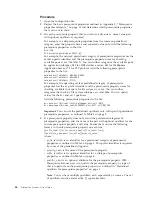
Creating custom collectors for Windows systems
You can create custom connectors if the basic set collectors do not collect values for
the prerequisite properties required for the product to be installed. You can create
custom common VBScript collectors to collect data for prerequisite properties that
apply to any product and product version. Alternatively, you can create custom
product-specific ones to collect data that apply to a specific product and product
version. While each type of custom VBScript collector collects data by using the
same methods, the rules for creation, storage, and execution are slightly different.
Creating custom VBScript collectors common to all
configuration files
When you create custom common VBScript collectors, the file name must contain
the name of the prerequisite property and stored in the
/lib
subdirectory. The
collector contains code to obtain the actual value for a prerequisite property. It can
also use the common functions and sub routines to obtain the value if required.
Before you begin
Ensure that you review the set of predefined functions and sub routines in the
following appendixes before you create the collectors. Determine whether you can
use any of them to obtain the actual values:
v
Appendix E, “Common functions for Windows systems,” on page 113
v
Appendix G, “File utility sub routines for Windows systems,” on page 129
v
Appendix F, “Logging utility sub routines for Windows systems,” on page 127
v
Appendix H, “Other common functions and sub routines for Windows systems,”
on page 131
Determine whether the collector must check that the prerequisite property exists
and if it does, what other information must be gathered. Each check must return a
value, whether one exists or not. For example:
v
Check whether an environment variable exists, such as the home directory of a
product, for example
TCR_HOME
for Tivoli Common Reporting.
v
Check whether the environment variable contains a JAR file, binary, or path,
such as the path to the JRE in the
PATH
environment variable.
v
Check the actual value of an environment variable, such as the home directory
of a product, for example
TCR_HOME
for Tivoli Common Reporting.
v
Check whether a product is installed.
v
Check what version of the product is installed.
Procedure
1.
Create a VBScript file. Save the file in the
ips_root
/lib
directory, with a variant
of the following file naming convention:
[
prefix_identifier
.]property_name.vbs
where:
v
prefix_identifier
is the prefix identifier for a predefined category of
prerequisite properties as outlined in Table 3 on page 4.
v
property_name
is the prerequisite property name and is used in the collector
name.
46
Prerequisite Scanner: User's Guide
Summary of Contents for Prerequisite Scanner
Page 1: ...Prerequisite Scanner Version 1 1 1 10 User s Guide ...
Page 2: ......
Page 3: ...Prerequisite Scanner Version 1 1 1 10 User s Guide ...
Page 8: ...vi Prerequisite Scanner User s Guide ...
Page 10: ...viii Prerequisite Scanner User s Guide ...
Page 40: ...Figure 6 result txt file on Windows systems 30 Prerequisite Scanner User s Guide ...
Page 46: ...36 Prerequisite Scanner User s Guide ...
Page 68: ...58 Prerequisite Scanner User s Guide ...
Page 78: ...Figure 11 precheck log file with the debug data 68 Prerequisite Scanner User s Guide ...
Page 84: ...74 Prerequisite Scanner User s Guide ...
Page 88: ...78 Prerequisite Scanner User s Guide ...
Page 92: ...82 Prerequisite Scanner User s Guide ...
Page 116: ...106 Prerequisite Scanner User s Guide ...
Page 122: ...112 Prerequisite Scanner User s Guide ...
Page 136: ...126 Prerequisite Scanner User s Guide ...
Page 138: ...128 Prerequisite Scanner User s Guide ...
Page 140: ...130 Prerequisite Scanner User s Guide ...
Page 158: ...148 Prerequisite Scanner User s Guide ...
Page 164: ...154 Prerequisite Scanner User s Guide ...
Page 166: ...156 Prerequisite Scanner User s Guide ...
Page 170: ...160 Prerequisite Scanner User s Guide ...
Page 171: ......
Page 172: ... Printed in USA ...






























